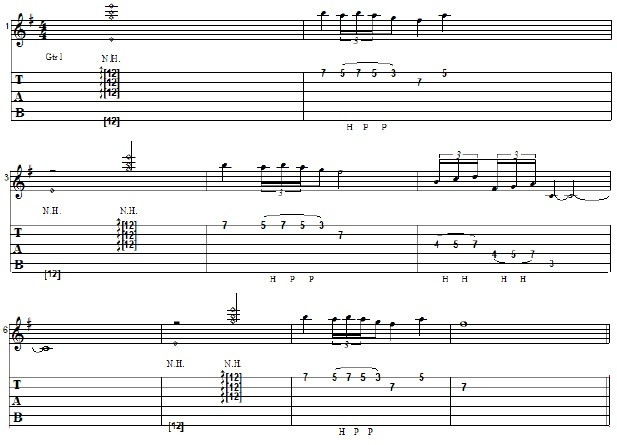The progressive rock masterpiece “Roundabout” by Yes is instantly recognizable, and its enchanting intro riff is a favorite among guitarists. This lesson is designed for beginners eager to tackle this classic piece, focusing on the opening section and utilizing the beautiful sound of natural harmonics. We’ll break down the riff step-by-step, making it accessible even if you’re just starting your guitar journey. Get ready to impress your friends with this iconic intro!
Understanding Natural Harmonics
Natural harmonics are ethereal, bell-like tones produced on a guitar string without fully pressing down on a fret. Instead, you gently touch the string directly above a fret – most prominently at the 5th, 7th, and 12th frets. For this “Roundabout” intro, we’ll be focusing on the 12th fret harmonic.
To play a natural harmonic, position your finger lightly on top of the 12th fret wire, without pressing the string down to the fretboard. When you pluck the string, lift your finger off almost instantaneously. This technique requires a delicate touch and precise timing, so don’t worry if it takes a little practice to get a clean, ringing harmonic. It’s about finding that sweet spot where you touch and release just right.
 Roundabout guitar tab – learn the intro riff with this tab for guitar
Roundabout guitar tab – learn the intro riff with this tab for guitar
“Roundabout” Intro Riff – Step-by-Step Guitar Tab
This intro riff is broken down into manageable parts. We’ll start with the harmonic section and then move into the fretted notes. Fingerpicking is recommended for this section to achieve the intended delicate sound, although it’s not strictly a fingerpicking song overall.
Part 1: Harmonic Section
We begin by playing natural harmonics on the 12th fret of the 6th, 3rd, 2nd, and 1st strings. Use your picking hand fingers to pluck the strings in sequence. A common approach is to use your thumb for the 6th string, first finger for the 3rd, second finger for the 2nd, and third finger for the 1st. Pluck the 6th string first, immediately followed by the 3rd, 2nd, and 1st strings in quick succession.
Imagine the tab like this (H indicates Harmonic):
e|---12(H)---
B|---12(H)---
G|---12(H)---
D|-----------
A|-----------
E|-12(H)-----Part 2: Fretted Notes Section
After the initial harmonics, we transition to fretted notes. Place your first finger on the 3rd fret of the 1st string, your second finger on the 5th fret, and your fourth finger on the 7th fret. Play the 7th fret, then pluck the 7th fret again and immediately hammer-on to the 5th fret, pull-off back to the 5th fret, and then pull-off to the 3rd fret. Finally, play the 7th fret on the 2nd string, followed by the 5th fret on the 1st string.
This section can be visualized in tab form as:
e|-7h5p5p3-7-5-|
B|-------------|
G|-------------|
D|-------------|
A|-------------|
E|-------------|Part 3: Variation and Scale
The riff repeats with a slight variation. You’ll start again with the harmonic on the 6th string and then the harmonics on the 1st, 2nd, and 3rd strings, followed by the same fretted note pattern as before, but this time omitting the final note on the 1st string. After the 7th fret on the 2nd string, move to the 4th fret on the 3rd string, pick it, and hammer-on to the 5th fret, then to the 7th fret. Repeat this hammer-on sequence on the 4th string and conclude on the 3rd fret of the 5th string.
This part of the tab looks like this:
e|-7h5p5p3-7---|
B|-------------|
G|-4h5h7-------|
D|-4h5h7-------|
A|-3-----------|
E|---12(H)-----|Notice how these fretted notes towards the end of this section fall within the G Major scale, giving it that characteristic melodic feel. The riff then often returns to the harmonic section before moving into the more complex parts of the song.
Tips for Mastering Natural Harmonics
- Practice the Touch: The key to clean harmonics is the light touch and quick release. Experiment with different amounts of pressure and release timing to find what works best on your guitar.
- Don’t Get Discouraged: Natural harmonics can be tricky at first. Be patient with yourself and keep practicing. Consistency is key.
- Fingerpicking Practice: While not mandatory, fingerpicking can make playing the harmonics and subsequent notes smoother. Try using your thumb and fingers as described earlier for a more controlled sound.
- Explore Further: If you enjoy playing with natural harmonics, check out the song “Red Barchetta” by Rush. It’s another great example of using natural harmonics in a rock context and can provide excellent practice.
This opening riff of “Roundabout” is a fantastic way to start exploring natural harmonics and learn a piece of iconic guitar music. With practice and patience, you’ll be playing this recognizable intro in no time. Keep practicing and don’t forget to subscribe to our YouTube channel for more guitar lessons and tips!
